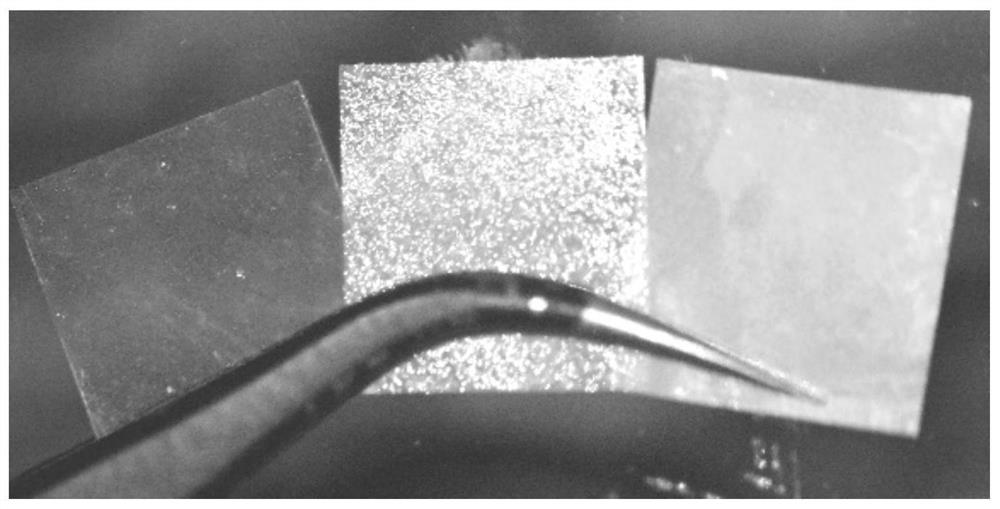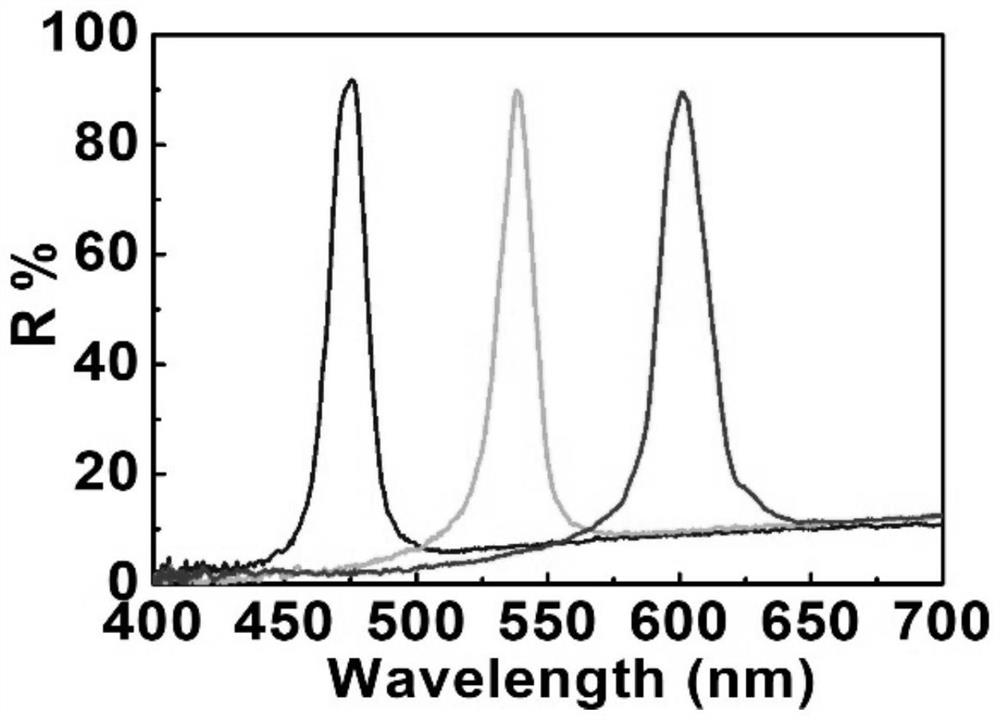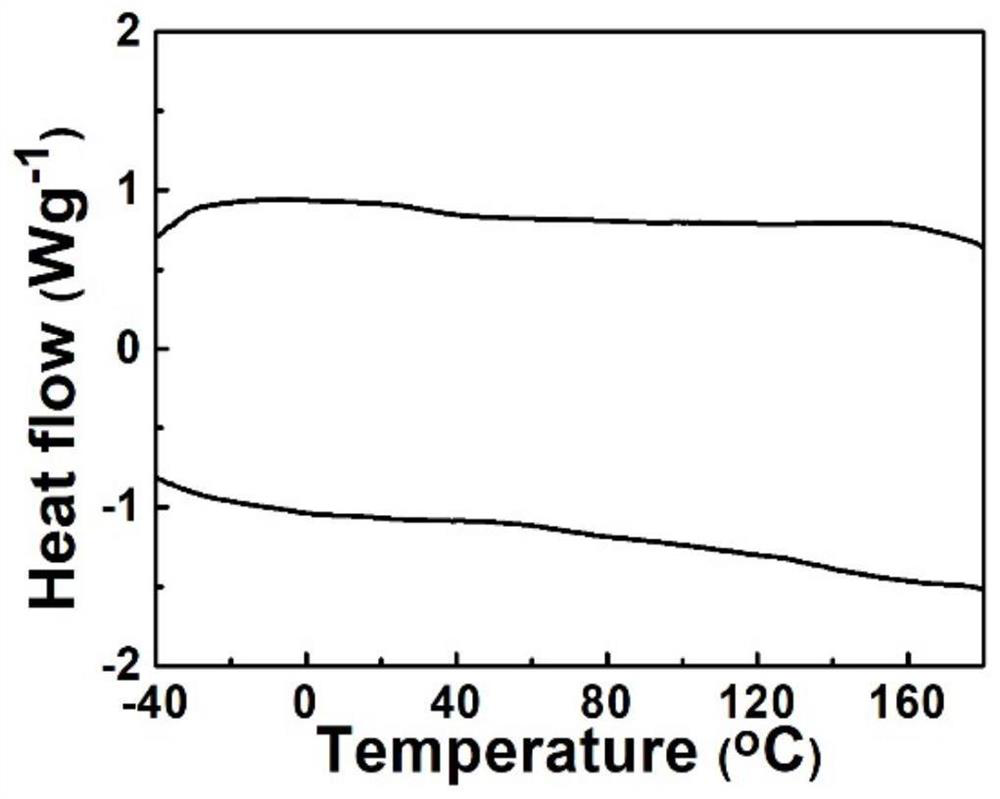Self-supporting blue-phase liquid crystal film and preparation method thereof
A blue-phase liquid crystal, self-supporting technology, applied in nonlinear optics, instruments, optics, etc., can solve the problems of high reflectivity and unstable blue-phase liquid crystal, achieve high reflectivity, widen the blue-phase temperature range, and stabilize blue-phase liquid crystals. The effect of phase structure
- Summary
- Abstract
- Description
- Claims
- Application Information
AI Technical Summary
Problems solved by technology
Method used
Image
Examples
Embodiment 1
[0080] 1) Mix chiral liquid crystal R5011, achiral polymerizable liquid crystal RM105, achiral polymerizable liquid crystal RM82, and non-liquid crystal cross-linking agent TMPTA, and their mass proportions are: 4.0%, 60%, 26%, and 10%, respectively , forming a liquid crystal mixture; adding a photoinitiator I-651 with a mass ratio of 1% to the liquid crystal mixture.
[0081] 2) Fully dissolve the liquid crystal mixture and the photoinitiator with dichloromethane, sonicate for 10 minutes, and then put it into a 60-degree drying oven to completely volatilize the dichloromethane to obtain a liquid crystal precursor;
[0082] 3) Pour the liquid crystal precursor into the glass sheet to assemble the liquid crystal cell;
[0083] 4) Place the liquid crystal cell on a temperature-controllable hot stage, and cool down to 82°C at a rate of 5-20°C / min at 100°C; then cool down to 75°C at a rate of 0.01-1°C / min to obtain blue phase state;
[0084] 5) Use 1~50mW / cm 2 Ultraviolet light...
Embodiment 2
[0087] 1) Mix chiral liquid crystal R5011, achiral small molecule liquid crystal mixture HTG135200-100, achiral polymerizable liquid crystal RM105, achiral polymerizable liquid crystal RM82, and non-liquid crystal cross-linking agent TMPTA, and the mass proportions are respectively: 3.5%, 68%, 15%, 10%, 3.5%, to form a liquid crystal mixture; add photoinitiator I-651 with a mass ratio of 1% to the liquid crystal mixture.
[0088] 2) Fully dissolve the liquid crystal mixture and the photoinitiator with dichloromethane, sonicate for 10 minutes, and then put it into a 60-degree drying oven to completely volatilize the dichloromethane to obtain a liquid crystal precursor;
[0089] 3) Pour the liquid crystal precursor into the glass sheet to assemble the liquid crystal cell;
[0090] 4) Place the liquid crystal cell on a temperature-controllable hot stage, and cool down to 82°C at a rate of 5-20°C / min at 100°C; then cool down to 78°C at a rate of 0.01-1°C / min;
[0091] 5) Use 1~50...
Embodiment 3
[0094] 1) Mix the chiral liquid crystal LC756, the achiral small molecule liquid crystal mixture HTG135200-100, the achiral polymerizable liquid crystal RM105, the achiral polymerizable liquid crystal RM257 and the non-liquid crystal cross-linking agent HDDA, and the mass proportions are respectively: 3.0%, 30.5%, 46%, 15%, 5.5%, to form a liquid crystal mixture; the photoinitiator I-651 with a mass ratio of 1% to the liquid crystal mixture is added.
[0095] 2) Fully dissolve the liquid crystal mixture and the photoinitiator with dichloromethane, sonicate for 10 minutes, and then put it into a 60-degree drying oven to completely volatilize the dichloromethane to obtain a liquid crystal precursor;
[0096] 3) Pour the liquid crystal precursor into the glass sheet to assemble the liquid crystal cell;
[0097] 4) Place the liquid crystal cell on a temperature-controllable hot stage, and cool down to 62°C at a rate of 5-20°C / min at 100°C; then cool down to 59°C at a rate of 0.01-...
PUM
 Login to View More
Login to View More Abstract
Description
Claims
Application Information
 Login to View More
Login to View More - R&D
- Intellectual Property
- Life Sciences
- Materials
- Tech Scout
- Unparalleled Data Quality
- Higher Quality Content
- 60% Fewer Hallucinations
Browse by: Latest US Patents, China's latest patents, Technical Efficacy Thesaurus, Application Domain, Technology Topic, Popular Technical Reports.
© 2025 PatSnap. All rights reserved.Legal|Privacy policy|Modern Slavery Act Transparency Statement|Sitemap|About US| Contact US: help@patsnap.com



